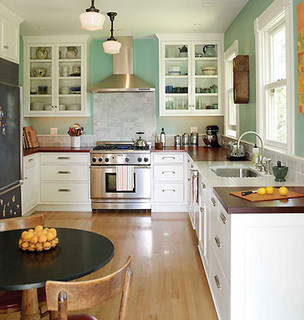When we first moved in, our next-door neighbours were an elderly Scottish couple. They had lived there for many years, with vegetables and fruit trees filling their back yard, but as Bill's health declined it had all gone a bit wild. A giant plum tree bloomed that first spring we were there, filling the air with petals that whirled like snow in the breeze. A mulberry tree overhung our yard, and I could see citrus. Cath gave me bags of her own home-grown oranges from time to time. "If you let the frost get to them, they're sweeter," she'd say, in her Edinburgh accent.
Cath and some other girls had been singing in the street to encourage people to attend a World Evangelisation Crusade event when Bill saw her and thought, "I want to meet that girl!". They eventually married and came to Australia, where they raised three daughters. Bill asserted that they came to Australia to get away from the rain!
Bill was from Glasgow. Both Bill and Cath had the Two Tongues, so I don't think their families had been in towns very long. In its heyday, Bill's garden must have supplied them with most of their fruit and vegetables. But I must not let you think they lived some kind of suburban idyll in the Lucky Country. They had first landed in Rockhampton, a real shock to people used to a much cooler climate, and there had been years of hard work and little money. They had the grief all migrants know for relatives sick and dying far away. While I knew them in their serene later years, their lives were made hard for a long time by serious persistent sin by one of the couple. Devout Presbyterians themselves, it was bitter to find that their daughters were not believers, perhaps due to that sin.
My abiding memory of Bill is of him smoking his pipe and reading Berkhof on his front porch. He died clasping his wife's hand, bidding her, "See you!" in Gaelic, as he slipped into Heaven. Cath was heartbroken, but she continued to love the people around her. She knew everyone in the street and cared about them all. Colour, creed and lifestyle were never a barrier to a woman who wanted the world to know Christ. Two years ago, she was reunited with Bill.
And the garden? It deteriorated gently but inevitably, along with the health of its owners. The plum-tree blew down in a storm after we had had a few springs to enjoy it. Some of the other trees were taken out over the years, but there were still half a dozen citrus left when Cath died. The mowers kept coming, but they don't look after fruit trees. Finally, the house was cleaned up and sold. The owner readied it for rent through a hot summer, after which all but two of the trees were dead. The rest was grass, humps in the lawn indicating where fruit trees had once been tended.

Now we are renting Cath and Bill's old home while our own is extended, and I have very little to garden with -- just my herb troughs,

and the two remaining fruit trees, which were definitely the worse for wear.

The lemon tree had a healthy population of stink bugs (the only healthy thing about it), and both it and the orange tree had dead branches, and grass growing right to their trunks. You can see I'd started mulching them here.

Isn't it satisfying to get rid of stink bugs?

Pruning is pretty good too. Here's how things looked after mowing, mulching, and the heavy pruning had been done.

But it's not the garden Bill and Cath knew.
“All people are like grass,
and all their glory is like the flowers of the field;
the grass withers and the flowers fall,
but the word of the Lord endures forever.”





































